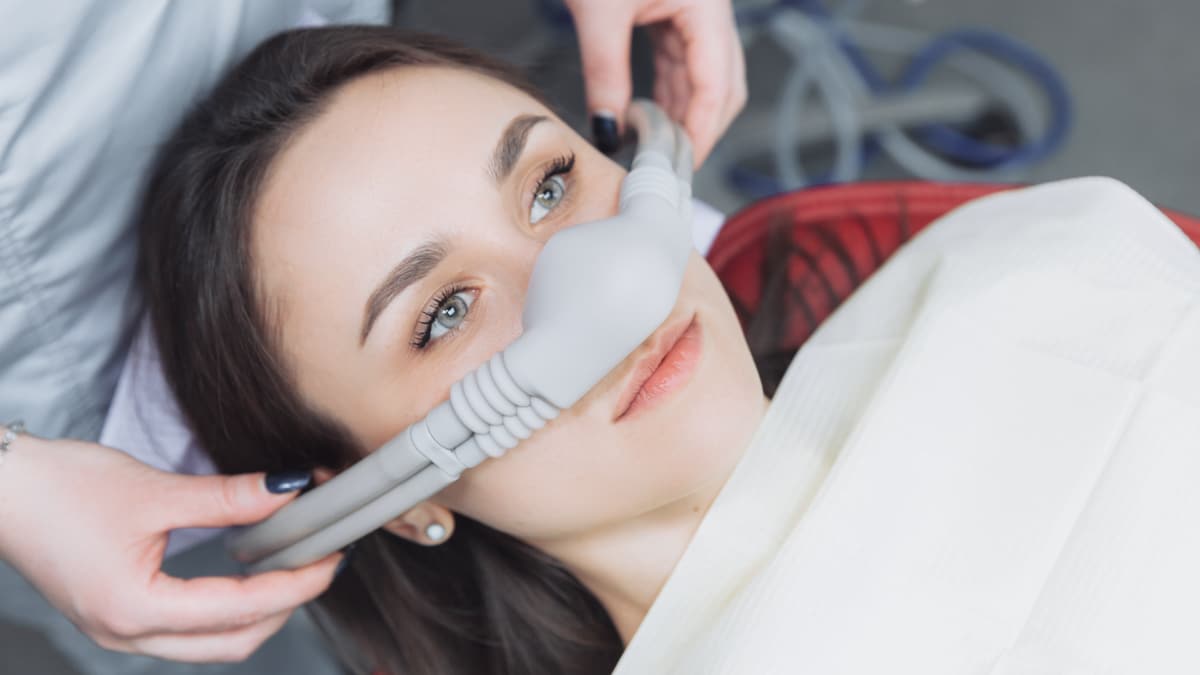Laughing gas sedation
Nitrous oxide sedation is an excellent way to treat anxious patients in our practice. We are happy to respond to the concerns and fears of our patients. This includes dental sedation in our practices in order to offer a carefree, relaxed and pain-free treatment.
- Specialized in dental anxiety
- Absolutely painless treatment methods
- Family practice for 40 years, in 2nd generation

Nitrous oxide - a proven and gentle method for relieving anxiety
There have been many major advances in dentistry in recent years and decades. The digital possibilities with 3-dimensional X-rays and their planning and minimally invasive surgical techniques have contributed to increasingly gentle treatment.
At the same time, procedures that help anxious patients in particular have been developed further and further. According to international studies, over 40% of the population in the western world still avoid going to the dentist simply because of their fear of pain at the dentist.
It is therefore not surprising that more and more dentists are resorting to treatments such as nitrous oxide sedation.
The simple and safe procedure of sedation with nitrous oxide in particular provides the patient with a more relaxed and stress-free time in the dentist’s chair.

“Some people delay their visits to the dental practice due to their dental anxiety until there is no other way out because of the severe pain. Dr. Hager’s practices offer the option of sedation with nitrous oxide. Patients report a feeling of well-being and a strong alleviation of anxiety afterwards. In most cases, patients then choose to continue their treatment without nitrous oxide, as they are now confident that their treatment will be pain-free. This means that nitrous oxide sedation even has a kind of therapeutic effect. Of course, we dentists enjoy taking away the patient’s fear.”
Dr. Eva Krapf
Procedure for nitrous oxide treatment
Nitrous oxide sedation begins with the supply of oxygen using a small, suitable nasal mask, then the dosage of N2O gas (laughing gas) is gradually increased. The sensation is light and pleasant. After a short time, about 5 minutes, sedation for the procedure is achieved. The body only has to break down 0.004% of the nitrous oxide.
The remaining 99% is simply exhaled again unchanged. This state is maintained throughout the treatment. When the dentist has completed this relaxed treatment for the patient, the inhalation of nitrous oxide is also stopped. The patient now remains in the dentist’s chair for about 10 minutes.
Why nitrous oxide?
Despite the introduction of local anesthesia in dentistry, visits to the dentist are still associated with fear and pain. Not so long ago, many dentists did not anaesthetize patients at the treatment sites in their mouths. At the dental practices of Dr. Hager in Constance near Kreuzlingen and Bietingen near Schaffhausen, local anaesthetics have been used consistently for over 40 years.
The causes of fear of the dentist are also due to the fact that parents teach their children to be afraid of the dentist. Children expect nothing but fear and pain at the dentist. It is therefore important for the patient to feel comfortable, to experience a relaxed atmosphere and stress-free treatment in the practice.
This is the reason why medical nitrous oxide is becoming an increasingly popular cornerstone of dental treatment.
In addition to nitrous oxide, there are many other types of sedation. These include: Propofol sedation (blood pressure drop and heart rate reduction as a side effect), sedation with benzodiazepines such as Dormicum (closer monitoring and more complicated than nitrous oxide sedation).
Sedation must be clearly distinguished from anesthesia, for example. However, nitrous oxide sedation is the method of choice today, as it has the lowest complication rates and is also very comfortable for the patient.

The advantages of nitrous oxide:
- Relieving anxiety in anxiety patients
- Gag reflex is reduced
- Long treatments have a short effect
- Full consciousness compared to anesthesia with full unconsciousness
- approachable
- Relaxation
- No additional medication necessary
But what does sedation mean and what is the effect of nitrous oxide?
Sedation is understood to mean sedation with medication. With nitrous oxide, this is done with a mixture of oxygen and nitrous oxide. The nitrous oxide is slowly increased to bring about the effect. The sedative effect occurs within a few minutes without the nitrous oxide restricting vital functions such as breathing and reflexes. Shortly after the first inhalation, a feeling of well-being – known as anxiolysis – sets in.
The stress and anxiety fade and the threshold for pain rises. Now the dentist can anaesthetize the treatment site in the mouth. Anxious patient or no dental anxiety – nitrous oxide has the same effect on both. Even the gag reflex is reduced by laughing gas. The sense of time is lost so that a long treatment is not a problem for the patient.

We look forward to seeing you!
Are you looking for advice and professional treatment? Would you like to know which nitrous oxide treatment is right for you? We will be happy to advise you and help you further. The easiest way to do this is to book your appointment online.

and the entire Dr Hager team

Frequently asked questions about nitrous oxide sedation
Are there frequent complications?
No, nitrous oxide sedation for anxious patients is extremely safe and tested. The use of nitrous oxide is considered the safest form of sedation in medicine. It is easy to use, easy to control and, thanks to its effect, provides anxiety-free treatment for anxious patients. Allergic reactions to nitrous oxide have not been documented in the last 150 years.
Can I talk to the dentist during the treatment, e.g. if I am in pain?
Yes! You are fully conscious for the entire duration of the treatment. Only the pain threshold is lowered and you are sedated by the gas. The nerves in the treatment area are anesthetized by the subsequent painless anesthetic injection. In contrast, you are heavily anesthetized and unconscious during anesthesia.
Do I have to take additional medication?
You do not have to take any medication before or after the treatment due to the nitrous oxide sedation.
What causes toothache?
This is often caused by a lack of oral hygiene. If proper dental care is not carried out on a daily basis, bacteria can attack healthy teeth and cause tooth decay. Bacteria work their way further and further into the tooth and reach the inner layers of the tooth. Stimuli such as cold water, sweet foods or fruit acids come closer and closer to the nerve in the tooth, causing the familiar toothache. Bacteria can also cause inflammation of the gums. This allows the bacteria to settle in the gum pockets and move deeper and deeper towards the root of the tooth. This also causes toothache.
Does it have an effect on my body after the treatment?
As an experienced German dental practice, we can answer this question with a clear “no”. The effect of the nitrous oxide is only limited to the addition of the nitrous oxide. Immediately after about 10 minutes, you will no longer feel any discomfort. You can leave the dental practice less than 10 minutes after the procedure without any compromises.

